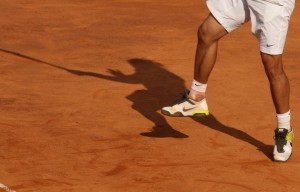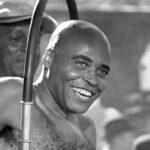Tennis, Sun, and the Mediterranean: It Must Be The Clay Season
 There’s something about the burnished, shimmering heat rising from the deep rust of a clay court that warms the spirit.
There’s something about the burnished, shimmering heat rising from the deep rust of a clay court that warms the spirit.
Sure, the tennis Tour started more than three months ago in the heat and humidity of the Asian Pacific swing. January hurtled through five hard-court events in the space of a fortnight on its way to the youthful camaraderie of the Australian Open. The players must feel they are on board a runaway bus, so fast and furious is January.
February, by comparison, offers an assortment of vehicles to destinations in every corner of the world.
Fancy some respite from the punishing hard courts of January? Then head for the grandeur of Latin America and take in some of the most exotic cities in the tennis calendar: Santiago, Costa do Sauipe near Salvador, Buenos Aires, Acapulco.
These courts are the closest the modern game has to traditional clay: deepest orange; little fear of rain; warm scented surroundings.
The fans who support the “Golden Swing” are enthusiastic, informed, and passionate supporters of the many South American and Spanish stars who choose to play. This is, after all, the single oasis of live ATP tennis that the continent has in the year.
Many players prefer to keep their feet on the hard, synthetic surfaces in order to maximise their preparation for the first spike in the Masters calendar: Indian Wells and Miami.
For those, there is the beating sun of South Africa, Dubai, and Florida, or the indoor protection provided by Zagreb, Rotterdam, and Memphis.
But get those March Masters out of the way, and a new atmosphere creeps over the calendar. Because April and May provide the longest, unbroken phase of the year. It’s clay or nothing right up to arguably the classiest of the Grand Slams, the French Open.
It’s the tennis season that welcomes the players like a warm bath in which they can submerge themselves for eight solid weeks.
No need, either, to hurtle to the furthest corners of the world in order to work out on a new surface.
There are few time zones to cross, so body clocks can, for a whole two months, settle into benign sleep patterns, practice schedules, and down time.
And added to all this, the clay season is the most rich in ranking points: It contains no fewer than three Masters and one 500 event before the far-off riches of Roland Garros beckon.
So, yes, there is something about this season that warms the spirit. For who would not—even without all the practical benefits of this elongated clay swing—enjoy the circle of gold marked out by its tournaments?
The first stop is exotic Casablanca, a hop, skip, and a jump from southern Spain, sandwiched between the Atlantic and the flower-strewn Atlas Mountains.
Then it’s off to the culture and glamor of the finest that the Mediterranean coast of Europe has to offer: Monte Carlo, Barcelona, Rome, and Nice.
The names alone are enough to summon up visions of fashionable society migrating to The Med for “The Season.”
Tennis history is replete with tales of the great matches, the iconic players, and the famous fans who descended on the French Riviera during the first decades of the 20th century. Nice was, indeed, the setting for one of the most renowned match of all time between “The Goddess” and “The American Girl,” Suzanne Lenglen and Helen Wills.
But if the affluence and heat of this Mediterranean circle gets too much, there is the chance, in May, to migrate to the cooler sophistication of Munich, Belgrade, or Dusseldorf.
So the setting is perfect, the players are settled,and the rewards are huge. Time to dive in and soak up the atmosphere. For make no mistake, there is a sensuality about the clay-bound phase of the tour.
The color, seen for the first time, is a shock after the subtlety of grass or the blue crispness of the outdoor Flushing Meadows and indoor O2 arena.
The clay—dressed with crushed brick for enhanced mobility and drainage—ranges from the deep shade of rust on a dented car, through the vivid orange of a new flowerpot, to the mellow brown-earth shade of Italian palazzos.
The sun, when it shines—as it invariably does in these latitudes—applies a deep, glowing heat that makes the skin sing rather than singe.
And there are always flowers: flame colored pelargoniums, orange marigolds, crimson hibiscus.
There are always palms and pine trees, and almost every venue surrounds its courts with green, as though creating a natural tennis garden. Casablanca and Rome, for example, are like scaled down versions of Philippe Chatrier in Paris.
There is the smell of wild herbs—rosemary and thyme—and amid these natural scents there is also the perfume of well-heeled women wearing Chanel and bare-shouldered teenagers glistening with Ambre Solaire.
These tournaments also have a social soundtrack quite different from Wimbledon or Flushing, particularly at the French venues.
There is a buzz of networking from linen-clad businessmen, the chink of champagne flutes, and the rattle of plates from beneath striped canopies. More than once have players been known to pause while the serried ranks of boxes tone down the bonhomie.
In contrast, the enclosed intimacy of the show courts of Rome or Madrid creates a joyous and intense atmosphere in which enthusiastic fans cheer, gossip and bustle until play begins and the noise drops into hushed attention. That attention is absolute until a rally is over, and then the crowd explodes.
The particular pleasure of such attentiveness during play is that the sound of the tennis itself can be appreciated in its full variety.
Clay courts seem to produce a rounder, less crisp soundtrack than many hard courts, and this is overlaid by the skidding of feet on grit or the fast patter of sprints over the gravel. These sounds add to the rhythm of the longer-than-average rallies, the scuttering back and forth across the baseline, the shuttles towards the net.
Even the ubiquitous “hawkeye” system finds little value on the clay. The physical efforts of the players are written in a deep copper Morse code on the court itself. And, appropriately, those same spots and dashes, skids and dust clusters are scattered away by old-fashioned elbow grease between sets.
So the road to Paris, the Tour’s second Grand Slam, is packed with tradition, painted with Gaugin hues, and imbued with the sights and sounds of the Mediterranean personality. It also throws into the media spotlight a cluster of players who come into full blossom in this season.
Taking a backward look to the Latin American clay swing, it was the golden Spaniards, Juan Carlos Ferrero and David Ferrer who stole the honors. The former was the title-holder of this week’s Casablanca, though two other clay court specialists, Stanislas Wawrinka and Victor Hanescu vie for the title this time.
The self-styled “Gem Of the Mediterranean”, the Monte Carlo Masters, is set like a topaz alongside the blue sea, and brims with history: more than a 100 years of it.
Sponsored by Rolex, it reeks of money and class. Little wonder that one of the all-time masters of clay, Rafael Nadal, has determined to attempt his sixth consecutive title in one of the most popular events on the Tour.
On to the historic Barcelona 500, held at the oldest tennis club in Spain. Here, Nadal has also won the last five titles on the trot: a staggering double tournament run. Last year, and the year before that, he beat fellow Spaniard Ferrer.
Nadal regards this as his home tournament and will desperately want a sixth title. This cosmopolitan and flamboyant city will desperately want him to win it, too.
In Rome, the first compulsory Masters of the clay swing, Nadal is also the title-holder.
Last year, he deprived the then champion, Novak Djokovic, from retaining his title. The scintillating Spaniard, as a result, notched up a record-breaking fourth Rome title.
After Italy, the players can ricochet in different directions. Roger Federer, for example, intends to head for the salt-laden wind of Portugal’s Estoril. Marin Cilic is scheduled to head for the mountains of Bavaria in one of Germany’s oldest tournaments. Djokovic will head to his home tournament in Belgrade.
Then it’s the last Masters until August: Madrid.
Suddenly, on the high plains of Spain, the clay season takes on a slight edginess in this youngest of the major clay events. Last year, Madrid became an outdoor event for the first time and, as if to assert its new status on the Tour, attempted to break the mold.
Its stunning new centre, the Magic Box, lived up to its name, with wind entering the high, enclosed environs of the Santana and the Sanchez Vicario courts and, quite literally, kicking up a storm.
But the venue came in for criticism before the tournament even began: too few practice courts, poor court bounce, and slippery surfaces that made it difficult for players to change direction.
Most controversial of all, the organisers proposed changing the clay to blue in tune with their main sponsor. Despite a test court being built on the outskirts, the players objected to having the show courts switched to blue.
Amongst the swirling dust, flying balls, and frequent hosing of the courts, the anticipated champion faltered. Nadal lost to Federer on clay for the first time since Hamburg 2007. It marked an important watershed in the fortunes of the two champions. Who knows what this year’s Madrid will bring?
Within little more than a week, the clay season reaches its climax in Paris.
Roland Garros is like all the other clay tournaments rolled into one. Orange and green, traditional yet with a certain arrogance born of innate confidence. Intimate—Philippe Chatrier holds just over 15,000—yet within the suburbs of Paris itself.
But it’s planning change, for it does not enjoy the relatively dry, hot climate of the Med. So it is following Wimbledon’s lead and constructing a roof: That is, if it does not up sticks altogether and move to a new venue.
Now that would be a break with tradition for one of the oldest venues in the sport.
Perhaps the French Open will consider following Madrid’s lead and change to blue clay. Then again, it could switch to the faster green grit of the North American “clay.”
If the culmination of the terracotta season did end in blue, though, Paris might just see the guillotine on its streets again!

















